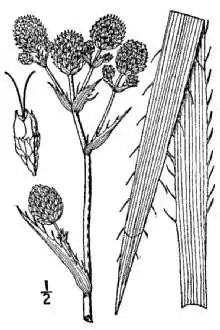| Rattlesnakemaster | |
|---|---|
 | |
| Eryngium aquaticum[1] | |
| Scientific classification | |
| Kingdom: | Plantae |
| Clade: | Tracheophytes |
| Clade: | Angiosperms |
| Clade: | Eudicots |
| Clade: | Asterids |
| Order: | Apiales |
| Family: | Apiaceae |
| Genus: | Eryngium |
| Species: | E. aquaticum |
| Binomial name | |
| Eryngium aquaticum | |
| Synonyms[3] | |
| |
Eryngium aquaticum is a species of flowering plant in the family Apiaceae known by the common name rattlesnakemaster,[4] marsh rattlesnake master,[2] corn-snakeroot, bitter snakeroot, and marsh eryngo.[5] This plant is native to eastern North America.[2]
This biennial or perennial herb grows up to 2 meters tall. The ribbed, erect stem branches toward the top. There are alternately arranged leaves which are lance-shaped and toothed on the edges. The basal leaves may be up to 90 centimeters long by 9 wide. The inflorescence contains white to blue flower heads with spiny, blue-tinged bracts.[5]
In the wild this plant grows in wet soils, such as those by bogs, marshes, and ditches. It tolerates saturated soils and periodic flooding.[5]
This plant had a number of medicinal uses for Native American groups. The Cherokee people used it for nausea.[6] The Choctaw people used it as a remedy for snakebite and gonorrhea, and the Delaware people used it for intestinal worms.[6] Many groups made it into tea to treat gastrointestinal complaints. The Koasati attributed magical powers to the plant.[4]
This plant is used in flower arranging and as an ornamental garden plant.[5] However, most plants sold under the name E. aquaticum are actually specimens of Eryngium yuccifolium.[5][7]
References
- ↑ Britton, N.L., and A. Brown. 1913. An illustrated flora of the northern United States, Canada and the British Possessions. 3 vols. Charles Scribner's Sons, New York. Vol. 2: 622. Courtesy of Kentucky Native Plant Society. Scanned by Omnitek Inc.
- 1 2 3 Eryngium aquaticum. NatureServe.
- ↑ The Plant List: A Working List of All Plant Species, retrieved 1 October 2015
- 1 2 Eryngium aquaticum. USDA Plants Profile.
- 1 2 3 4 5 Eryngium aquaticum. USDA NRCS Plant Guide.
- 1 2 Eryngium aquaticum. University of Michigan Ethnobotany.
- ↑ Eryngium aquaticum. Missouri Botanical Garden.
